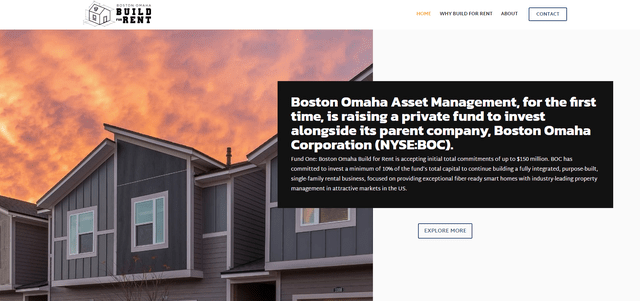Kativ
Going from a singular sushi restaurant to a $750 million diversified conglomerate in 7 years is no easy feat and is not achieved by luck. Determined to build a durable company capable of achieving responsible growth, Boston Omaha Corporation (NYSE:BOC) founders Adam Peterson and Alex Rozek leveraged their keen ability to value businesses and recognize opportunity. The company is focused on investing in and owning simple, profitable, high margin businesses. As you can imagine, this won’t lead to an immediate sky high valuation and mass speculation driving up stock prices. However, what it does do is build a company with a strong foundation and intrinsic value. Boston Omaha Corporation is one of my highest conviction picks for several reasons, maybe it should be on your radar too.
The Business Model
Boston Omaha Corporation is indeed a conglomerate. However, it does have some important differences that set it apart from the rest. Sticking true to its founders’ mission of building a durable company, BOC operates on the belief that cash is king and that debt should be avoided. To make this possible, they use the numerous levers that are at their disposal as a publicly traded company such as secondary offerings and participating in alternative public offerings such as SPAC’s. This is evidenced by the fact that Boston Omaha carries a miniscule amount of long-term debt at just $27 million. They have deployed a significant portion of their cash over the last 6 months with acquisitions, but still hold roughly $40 million in cash and equivalents on the balance sheet while producing over $100 million in free cash flow per year.
Secondly, they employ the method of acquiring non-controlling stakes in companies, as opposed to the typical approach of most conglomerates who wholly acquire businesses. The rationale here is in line with the company mission, that it is better to let a wonderful company continue operating wonderfully. Also, this allows them the option to benefit from their operations via look-through earnings, essentially allowing the investees to retain earnings and use them to grow the business for greater future long-term growth. A great example of a minority investment would be the roughly 8x realized/unrealized gains for BOC from a pre-IPO investment in Dream Finders Homes (DFH) in a time horizon of just 4 years. An example of using the look-through approach and allowing the company to retain all of its earnings to fuel future expansion is the growth of Crescent Bank and Trust, which BOC has a minority interest in. The value of BOC’s stake is believed by management to be drastically higher than its original purchase value.
The reason Boston Omaha Corporation is able to generate such high volumes of free cash flow and invest in numerous companies is due to the nature of the businesses they operate. Operating in four main segments, each division operates in high cash flow industries that are able to provide steady reliable profits. The four main segments are:
- Billboards – Through their subsidiary, Link Media, they own and operate nearly 4,000 billboards. A simple business with low costs that is easily scalable through acquisitions.
- Insurance – Providing a necessity-like service such as surety bonds, Boston Omaha is able to gain revenues from premiums written. On top of this, they take advantage of the “float” that insurance companies naturally produce to purchase income-producing securities.
- Broadband – This rapidly growing segment provides high speed internet service to 43,000 rural monthly-paying subscribers. The margins in this business are extremely high and BOC has been expanding its subscriber base rapidly. There are also significant opportunities with new home builds and last-mile fiber network connections. In Q2 2022, revenues grew over 100% from Q2 2021 to $8.1 million.
- Boston Omaha Asset Management – The youngest of the four wholly owned businesses. BOAM has hit multiple home runs already, a detailed report of its performance can be found here on page 8 in the latest annual letter. The subsidiary sponsored a SPAC through a BOC owned blank check company that successfully closed with a business combination, which may actually be more of a feat than it seems given the high number of SPAC’s that failed to combine. At first glance this may seem out of character given the speculative nature of SPACs. However, the combined business, Sky Harbour (SKYH), is an aviation infrastructure company with a disruptive business model. Construction of hangars are either now in operation or in development at 6 sites across the United States. It may take a few years before Boston Omaha is able to see a return on their investment, but it appears intriguing to say the least. The newest offering of investable funds by BOAM is the real gamechanger and will be discussed in the next section.
Company Growth
In just 5 years, BOC has grown revenues from $9 million to $67 million, that’s a 7.5x increase. The company prefers to value the company based on intrinsic value reflected in the book value per share, looking at this metric over the same time period we see an increase from $147.2 million in total common equity on the balance sheet to $501.4 million for 3.4x gain. However, the book value per share has only risen by 65% to $16.88.
There are several reasons for this. It is largely due to the total outstanding shares more than doubling during this time as share dilution was the preferred strategy of the board over issuance of debt. Secondly, the equity method of accounting does not accurately capture the increased asset value of minority interests in other companies. Due to GAAP rules, the asset values of these investments in privately owned companies are recorded as the purchase price and only increase or decrease based on distribution of attributable earnings or receipt of dividends. Due to the fact that Boston Omaha has allowed several investees to retain all earnings, the actual asset value of these minority interests are likely substantially higher. I will attempt to estimate these values later in this article.
The company has witnessed strong growth in all of its business divisions and has expressed excitement for the future, especially in broadband. However, the recent developments in the asset management division could be the additional catalyst needed to bring Boston Omaha to the next level. This development is the announcement of the Fund One: Build For Rent investable fund for outside investors, also known as “BFR.” For the first time, outside accredited investors will be able to invest alongside BOAM in a fund with the goal of developing build-for-rent residential real estate. They have stated the ultimate goal would be the eventual spinoff of this portfolio into a real estate investment trust (“REIT”), a highly lucrative maneuver for BOC. If the targeted level of funds is raised, BFR will have $150 million in capital with $15 million contributed by BOC itself, the other $135 million would be able to generate income via management fees. The fund would invest capital into developing the real estate portfolio for the eventual spinoff.
The reason why this announcement is so exciting is due to the high potential cap rate BOC would be able to achieve by leveraging its own subsidiaries. They will be able to obtain significantly increased profitability metrics over standard REIT’s by building out the fiber network for the properties through their own subsidiaries, using the property management software owned through BOC’s acquired companies (Logic Commercial Real Estate and Breezeway), reducing management costs due to the ownership of BOAM, and reducing build/repair costs via bulk-ordering for all of the materials for the new properties. Per the annual meeting, they hope to achieve an impressive 7% cap rate. If this was achieved on the $150 million value of invested capital, net income produced by this fund would be $10.5 million from the properties as well as profits from management and performance fees.
Fund Description (Boston Omaha)
Valuation
Unlike most companies, P/E ratios don’t really paint an accurate picture for the value of conglomerates such as Boston Omaha. This is due to the fact that BOC owns a hefty number of assets, physical and monetary. Additionally, the GAAP required rules of reporting unrealized gains and losses on investments allow for large swings in reported net income from quarter to quarter. The most accurate way to value BOC would be using the price to book ratio, a view that company executives also share. In the latest earnings report, long-term investment assets were valued at $135.6 million.
Let’s analyze what the true value might look like based on each of the assets owned by the company:
- Sky Harbour stake of roughly 29% = $75 million at current market prices
- Dream Finders Homes stake of roughly 2.75 million shares at current market prices = $30 million
- Crescent Bank and Trust value estimation of $30 million. This is derived from the $19.1 million initial investment that was reported to be now worth an equivalent of 83% of the book value per share of the bank.
- 24th Street Asset Management value estimation of $8.5 million. This is directly derived from the latest annual report with an additional $0.5 million in appreciation since the report.
- Build For Rent Fund Assets = Latest update is from the 2021 annual report with a reported $7.2 million raised.
- Logic Commercial Real Estate value estimation of $1.5 million, based on management’s belief that the value is significantly higher than the $700,000 currently recorded.
- Breezeway value estimation of $250,000 based on company estimates.
In total, I estimate these assets are worth about $17 million more than currently recorded at a total value of $152.5 million. This would equate to a noticeable increase in the book value per share to $17.45. In an additional scenario, if the remaining ~$143 million were raised for Fund One, the investment assets would total $295.5 million leading to a massive jump in BVPS to $22.27.
To create an accurate price estimate, I will use a P/B multiple of 1.6, a value consistent with early stage Berkshire Hathaway (BRK.A, BRK.B) and similar to the average for conglomerates as a whole. In the table below, we can see fair value and bull case scenario price targets.
| Current | Fair Value | Bull Case | |
| BVPS | $16.88 | $17.45 | $22.27 |
| P/B x | 1.40 | 1.60 | 1.60 |
| Price | $23.56 | $27.92 | $35.63 |
Currently, I believe BOC shares are trading at an 18.5% discount to fair value as well as the potential to provide 51.2% returns in the near term if the bull case is realized.
Risks & Summary
Boston Omaha is one of my highest conviction picks in the market due to excellent management and a potential to slowly compound into a fortune by retirement. However, there are risks that need to be identified as well. The largest risk that I attribute to the company is execution risk. While they have proven themselves thus far with an impressive track record, there is no guarantee that this level of success will continue in the future. There is great upside for this company but as the company grows and enters into new territories, there will be greater obstacles.
Overall, I believe the high margin businesses owned by BOC will continue to snowball the cash flows for years to come. With a history of being great capital allocators, I believe the executive team has the ability and the opportunity to provide Boston Omaha shareholders with exceedingly great returns.


Be the first to comment